
A diesel multiple unit or DMU is a multiple-unit train powered by on-board diesel engines. A DMU requires no separate locomotive, as the engines are incorporated into one or more of the carriages. Diesel-powered single-unit railcars are also generally classed as DMUs. Diesel-powered units may be further classified by their transmission type: diesel–mechanical DMMU, diesel–hydraulic DHMU, or diesel–electric DEMU.
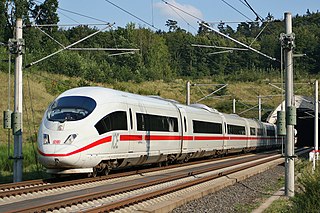
A multiple-unit train or simply multiple unit (MU) is a self-propelled train composed of one or more carriages joined, which when coupled to another multiple unit can be controlled by a single driver, with multiple-unit train control.

The American Locomotive Company was an American manufacturer that operated from 1901 to 1969, initially specializing in the production of locomotives but later diversifying and fabricating at various times diesel generators, automobiles, steel, tanks, munitions, oil-production equipment, as well as heat exchangers for nuclear power plants.

Railway electrification is the use of electric power for the propulsion of rail transport. Electric railways use either electric locomotives, electric multiple units or both. Electricity is typically generated in large and relatively efficient generating stations, transmitted to the railway network and distributed to the trains. Some electric railways have their own dedicated generating stations and transmission lines, but most purchase power from an electric utility. The railway usually provides its own distribution lines, switches, and transformers.

A railbus is a lightweight passenger railcar that shares many aspects of its construction with a bus, typically having a bus body and four wheels on a fixed base instead of on bogies. Originally designed and developed during the 1930s, railbuses have evolved into larger dimensions with characteristics similar in appearance to a light railcar, with the terms railcar and railbus often used interchangeably. Railbuses designed for use specifically on little-used railway lines were commonly employed in countries such as Germany, Italy, France, the United Kingdom, and Sweden.

The British Rail Class 76, also known as Class EM1, is a class of 1.5 kV DC, Bo+Bo electric locomotive designed for use on the now-closed Woodhead Line in Northern England.

Dieselisation is the process of equipping vehicles with a diesel engine or diesel engines.

The Sri Lanka Railway Department is Sri Lanka's railway owner and primary operator. As part of the Sri Lankan government, it is overseen by the Ministry of Transport. Founded in 1858 as the Ceylon Government Railway, it operates the nation's railways and links Colombo with other population centres and tourist destinations.
Medawachchiya is a town in the Anuradhapura District, North Central Province of Sri Lanka. Situated 27 km from Anuradhapura, on the A9 Jaffna - Kandy main road, it is 229 km from Colombo. Medawachchiya is also the point from which the A14 main road to Mannar and Talaimannar starts. Medawachchiya is a significant railway junction on Sri Lanka Railways' northern network. Medawachchiya is the junction between the Northern Line and the Mannar Line.

The Rameswaram Express, previously known as the Boat Mail or Indo-Ceylon Express, is an express train that connects Mandapam with the state capital Chennai via Tambaram, Chengalpet, Melmaruvattur, Viluppuram, Cuddalore port, Chidambaram, Sirkazhi, Mayiladuthurai, Tanjore, Tiruchchirappalli, Pudukkottai, Karaikudi, Sivagangai, Manamadurai and Ramanathapuram. During the 1900s, it was a combined train and steamer ferry service between India and Ceylon. Connecting Chennai and Colombo, the system initially utilised a rail-to-sea operation, but changed to a rail-to-sea-to-rail operation. Passengers could buy a single ticket for the journey. Now, it runs from Chennai Egmore to Rameswaram via Villuppuram, Kumbakonam, Tiruchchirappalli, Pudukkottai, Karaikkudi, Devakottai, Manamadurai, Paramakkudi, Ramanathapuram, Mandapam, and Pamban.

Yal Devi is a major express train in Sri Lanka. Operated by Sri Lanka Railways, the Yal Devi connects Colombo, the nation's commercial hub, with the northern cities of Jaffna and Kankesanturai. From 1990 up to 2015, the service had to terminate at intermediate stations, due to the Sri Lankan civil war. The Northern Line was rebuilt and returned to Jaffna Railway Station by October 2014 and Kankesanturai by January 2015.

Locomotives and train sets of Sri Lanka Railways consist mostly of diesel locomotives and multiple units. Steam locomotives are no longer used, except on heritage trains, such as the Viceroy Special.
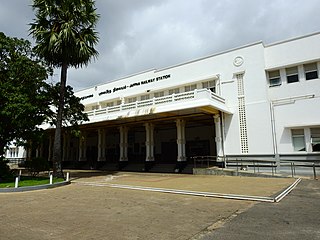
Jaffna railway station is a railway station in the city of Jaffna in northern Sri Lanka. Owned by Sri Lanka Railways, the state-owned railway operator, the station is one of the busiest in the country, linking the north with the capital Colombo.

The northern line is a railway line in Sri Lanka. Branching off the Main Line at Polgahawela Junction the line heads north through North Western, North Central and Northern provinces before terminating at the northern port of Kankesanthurai. The line is 339 kilometres (211 mi) long and has 55 stations between Polgahawela Junction and Vavuniya. It is the longest railway line in Sri Lanka. The line opened in 1894. Major cities served by the line include Kurunegala, Anuradhapura, Vavuniya,Kilinochchi and Jaffna. The popular Yal Devi service operates on the line. The line was severely affected by the civil war and no services operated north of Vavuniya after 1990. Reconstruction of this section of the line commenced following the end of the civil war in 2009 and was fully completed in early 2015.
The Mannar line is a railway line in Sri Lanka. Branching off the northern line at Medawachchiya Junction, the line heads north-west through North Central and Northern provinces before terminating at the town of Talaimannar. The line is 106 kilometres (66 mi) long and has 11 stations. The line opened in 1914.

The Main Line is a major railway line in the rail network of Sri Lanka and considered by many to be one of the most scenic train journeys in all of Asia. The line begins at Colombo Fort and winds through the Sri Lankan hill country to reach Badulla.
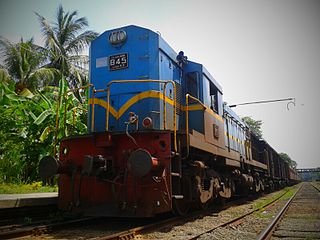
Sri Lanka Railways Class M8 is a class of Sri Lankan diesel-electric locomotive that was developed by Banaras Locomotive Works at Varanasi, India, in 1996. This class of locomotives was fitted with 2,800 hp (2,100 kW) V16 power units. This is used on both passenger and freight trains on Sri Lanka Railways.
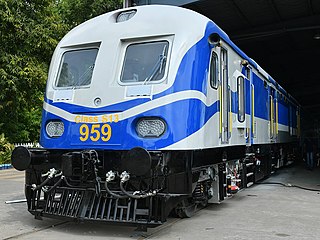
Sri Lanka Railways Class S13 is a Diesel-Electric Multiple Unit (DEMU) trainset, built for Sri Lanka Railways by Integral Coach Factory, Chennai and imported through RITES, an Indian Railways PSU on a line of credit extended by the Indian Government in 2011. Sri Lanka Railways Ordered for 6 modern state of the art DEMU trainsets in 2017. Class S13 possess AC First, Second and Third Class accommodations. The first trainset of the order arrived Sri Lanka in December 2018.

The Indian locomotive class WDM-3D is a class of diesel-electric locomotive that was developed in 2003 by Banaras Locomotive Works (BLW), Varanasi for Indian Railways. The model name stands for broad gauge (W), Diesel (D), Mixed traffic (M) engine with 3300 horsepower (3D). The engine is classified WDM-3D though it outputs only 3300 hp and not 3400 hp as the name should suggest. They entered service in 2003. A total of 590+ WDM-3D were built at Banaras Locomotive Works (BLW), Varanasi between 2003 and 2016.
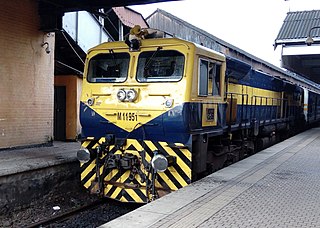
Class M11 is a mainline diesel-electric locomotive built by Banaras Locomotive Works, India, for use on Sri Lanka Railways and first delivered in 2018. This locomotive, clearly with its look, was developed from the WDG-4D locomotive of the Indian Railways, which is originally of 4,500 HP, as it uses a 16-cylinder variant of the EMD 710 prime mover. The HP was Down-tweaked to 3,000 using a 12-cylinder variant of the same engine, making it look and sound similar to British/European Railways' popular Class 66 EMD locomotive, but with AC-AC traction.



















